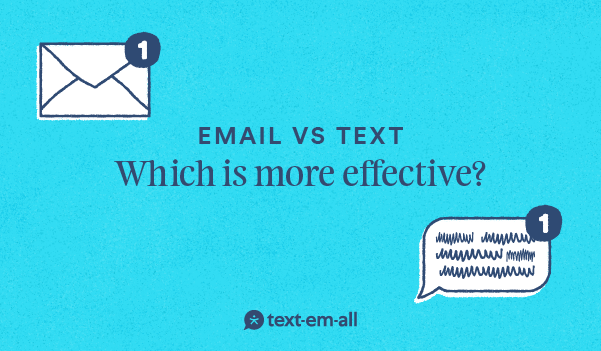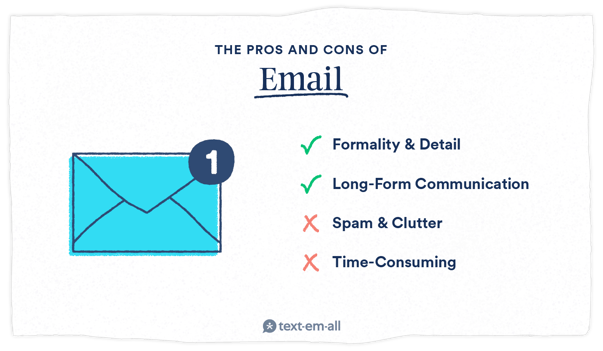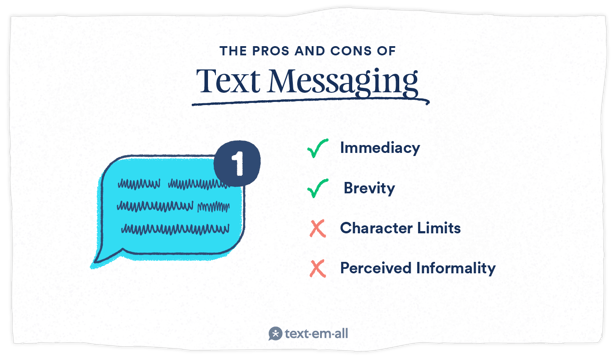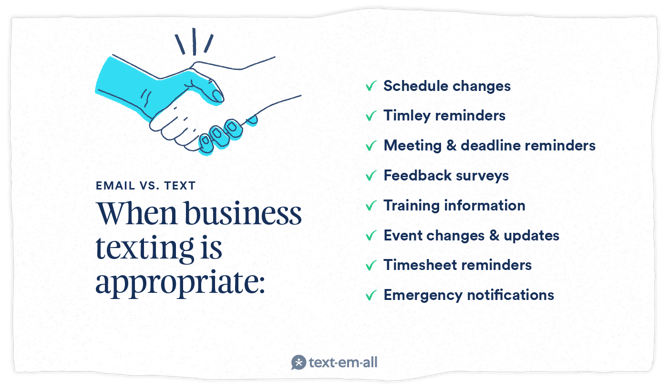
Key takeaway
Email is best for formal, detailed, and record-keeping communications, while text messaging excels at immediacy and engagement for urgent or time-sensitive updates. The most effective strategy is to blend both methods based on your audience and goals.
Communication has changed a lot since carrier pigeons and smoke signals. Today, email and text messaging lead the charge in how organizations connect with their audiences—whether you're sending appointment reminders, emergency alerts, or promotional campaigns. Both methods have pros and cons, so let's break them down step by step. For a comprehensive comparison focused specifically on marketing, check out our SMS vs email marketing guide.
In this guide, we'll examine the strengths and limitations of each method, helping you determine which approach works best for your organization's communication needs.
Email vs. text messaging: Quick comparison
| Feature | Text Messaging | |
|---|---|---|
| Open Rate | ~20% | 98% |
| Response Rate | 6% | 45% |
| Average Open Time | Hours to days | Within 3 minutes (90% of messages) |
| Click-Through Rate | ~2.5% | ~18% |
| Best For | Detailed information, formal communication, record-keeping | Urgent updates, time-sensitive alerts, quick engagement |
| Message Length | Unlimited (can include attachments) | Limited to 160 characters per segment |
| Tone | Formal and professional | Casual and immediate |
| Lifespan | Stays in inbox indefinitely | Often auto-deleted after ~30 days |
| Compliance Requirements | CAN-SPAM Act | TCPA (stricter consent requirements) |
| Starting Cost | Often free or low-cost | Text-Em-All starts at $19/month |
Pros and cons of email
Email has established itself as a reliable communication channel. It's been a cornerstone of business communication for decades, and many people expect to receive important information through email. Let’s explore the advantages and disadvantages of this communication method.

Pro: Formality and fetail
One of the significant advantages of email is its formal nature, making it ideal for professional correspondence. Emails allow for detailed communication, enabling users to convey complex information, attach files, and provide comprehensive context.
Pro: Long-form communication
Emails excel when it comes to conveying lengthy messages. Whether it's a detailed project proposal, a comprehensive report, or nuanced instructions, emails provide the space needed for expansive communication.
Con: Spam and clutter
One of the main challenges with email is the influx of spam. Sorting through a cluttered inbox can be time-consuming, leading to potential oversight of critical messages. The struggle to differentiate between important emails and promotional clutter remains an ongoing issue.
Con: Time-consuming
Crafting a well-thought-out email takes time, and waiting for responses can also contribute to delays. In a fast-paced world, the time investment required for email communication can be a drawback, especially for urgent matters.
Pros and cons of text messaging
SMS text messaging has become a core part of business communication strategies due to its high response rates and accessibility. By standardizing how we refer to it, we ensure clarity and consistency throughout this guide.
Pro: Immediacy
 Text messages are synonymous with instant communication. With high open rates and quick response times, text messages are ideal for time-sensitive matters, making them an excellent choice for urgent business updates or reminders.
Text messages are synonymous with instant communication. With high open rates and quick response times, text messages are ideal for time-sensitive matters, making them an excellent choice for urgent business updates or reminders.
Pro: Brevity
The concise nature of text messages ensures that information is delivered in bite-sized portions. This caters to the short attention spans of today's audiences and facilitates quick comprehension of the message.
Con: Character limits
While brevity is an asset, the character limits imposed on text messages can hinder conveying detailed or nuanced information. Complex topics may require a more extensive medium.
Con: perceived informality
With their shorthand and casual tone, text messages may be perceived as less formal than emails. This informality can be a drawback in professional settings where a more polished communication style is expected.
Read 6 Tips for writing an effective text message
Texting vs. emailing in a business context
This section compares email and text messaging for business. It focuses on three factors: formality, immediacy, and engagement potential. By understanding these differences, companies can tailor their communication approach to fit the audience and message type best.
Professionalism
Due to their formal nature, emails often take the lead in professional environments. Many industries still rely on email to document official communications. That said, text messaging boasts a 98% open rate and achieves a 45% response rate compared to email's 6%, representing a 7.5x advantage in customer engagement.
Record-keeping
For businesses that prioritize meticulous record-keeping, email has a distinct advantage. The trail of communication in emails is easy to follow, making it simpler to track agreements, decisions, and discussions over time.
Conveying complex information
When conveying intricate details or comprehensive information, email reigns supreme. You can attach documents and provide deep context. Its flexible formatting also makes organizing details easier. Email open rates hover around an industry standard of 20%, while text messages enjoy a 98% open rate — both serve distinct but crucial roles in business text messaging and communication.
When business texting is appropriate
While email handles formal business correspondence well, text messaging excels in numerous business scenarios where immediate communication matters most.
 Schedule changes
Schedule changes- Timely reminders
- Meeting and deadline reminders
- Feedback surveys
- Training information
- Event changes and updates
- Timesheet reminders
- Emergency notifications
- Promotional offers and flash sales
- New product or service announcements
- Customer loyalty program updates
Read The complete guide to business text messaging
Texting vs. emailing for informational and emergency messaging
When you need to share critical information quickly and ensure immediate response, text messaging provides the speed and reliability your organization needs.
Immediacy: Why speed matters in critical communication
Text messaging excels in situations where speed is essential. On average, 90% of text messages are read within three minutes of delivery, making them the go-to channel for urgent updates and emergency alerts. In contrast, emails can sit unopened for hours—sometimes even longer—especially outside of business hours. For example, during a recent severe weather event, one organization using Text-Em-All reached over 10,000 staff members with critical information in under five minutes. This immediacy ensures your audience receives and acts on important messages quickly, whether it's a last-minute schedule change or an emergency notification.
In urgent situations where time is of the essence, the immediacy of text messaging takes the lead. Unlike emails that might languish in inboxes, text messages are typically opened within minutes of receipt. This speed is crucial for disseminating time-sensitive information, such as emergency alerts or immediate updates.
High open and response rates
Text messages boast significantly higher open and response rates compared to emails. For informational and emergency messaging, capturing your audience's attention promptly is paramount. 83% of people say texting is their top mobile activity, so text messaging ensures that your message is seen and acted upon swiftly, making it the preferred choice for critical communication.
Concise for quick understanding
When conveying crucial information, brevity is key. Text messages, with their character limits, force concise communication, ensuring that the message is easily comprehensible at a glance. In emergency situations, where clarity and speed are paramount, the succinct nature of text messages becomes a powerful asset. This speed is crucial for disseminating time-sensitive information, such as emergency alerts or immediate updates.
Email vs. text in marketing
While the choice between email and text is straightforward for operational and emergency communication, marketing campaigns benefit from a strategic mix of both channels. Here's how they compare and why combining them delivers the best results.
Reach
Email marketing campaigns can reach a broader audience, especially considering the widespread use of email for both personal and professional communication. However, the open rates for text messages are generally higher, ensuring that a significant portion of your audience engages with the message. SMS achieves 90-98% open rates with 90% of recipients opening messages within 3 minutes, compared to email's 20-28% open rate for marketing messages. Using a combination of both will give you the best reach.
Engagement rate
Text messages often boast higher engagement rates due to their immediate nature. SMS marketing campaigns average click-through rates of around 18%, significantly outperforming email's typical 2.5% CTR. People are more likely to open and respond promptly to a text message than an email that might sit in an inbox for hours or even days. However, emails often stick around in inboxes for longer, as many phones delete text messages after about a month, so if you’re running a promotion that spans over a month, it would be more effective to use email. For strategies to maximize these engagement advantages, check out our SMS marketing tips and best practices.
Conversion rate
When it comes to conversion, the concise and immediate nature of text messages can be a powerful tool. Urgent promotions, flash sales, or limited-time offers are particularly effective when delivered via text. For example, retail businesses often see redemption rates 6-8 times higher for text-based coupons compared to email offers, especially when messages include a clear call-to-action and time-sensitive incentive. In contrast, many people view emails on their computers and may be more likely to make a purchase on your desktop site rather than their mobile device. Our detailed analysis of SMS marketing ROI shows how these conversion advantages translate to real business impact.
Compliance & consent
Regardless of the channel you choose, always secure clear opt-in first. Text messaging, in particular, comes with strict quiet-hour rules and carrier guidelines, so be sure contacts have explicitly agreed to receive your updates. Text-Em-All helps businesses stay compliant by managing opt-outs automatically, respecting quiet hours, and maintaining detailed consent records—giving you peace of mind while you focus on engaging your audience.
The Federal Communications Commission's enforcement advisory on robotexts confirms that TCPA regulations require prior express written consent before sending advertising or marketing text messages, with penalties up to $18,936 per violation. Our TCPA compliance checklist provides a comprehensive overview of requirements to help you comply with regulations.
Reach your mass texting goals with Text-Em-All
In the perpetual battle between email and text messaging, there is no one-size-fits-all answer. The choice between the two depends on the nature of your communication, audience, and specific objectives.
Ultimately, a strategic blend of both mediums might be the key. Understanding your audience and tailoring your communication methods accordingly will ensure that your messages are heard and resonate with your intended recipients.
If you're ready to experience the effectiveness of text messaging for your organization, Text-Em-All has you covered. Our mass texting service is designed to deliver your messages quickly and reliably—whether you're sending emergency alerts, appointment reminders, or marketing campaigns that drive real results. With two-way messaging capabilities for engaging conversations and affordable pricing starting at just $19/month, we make business texting simple and effective. Try it now and see how simple and impactful mass text and voice messaging can be!












